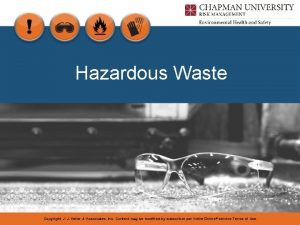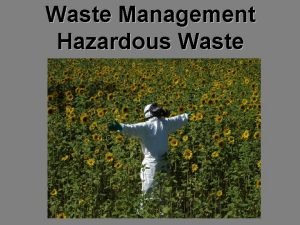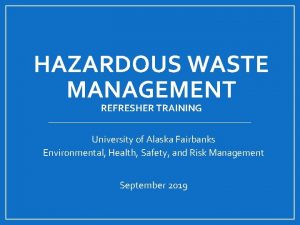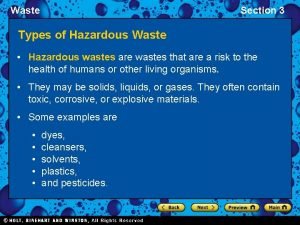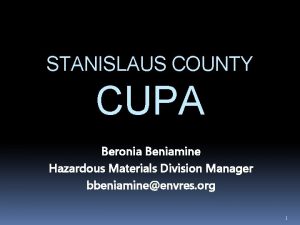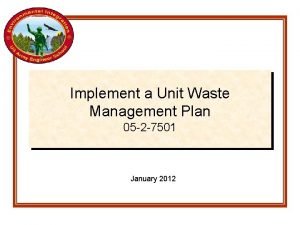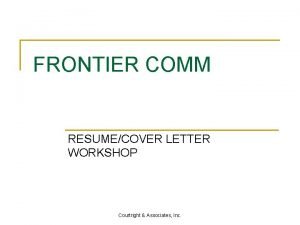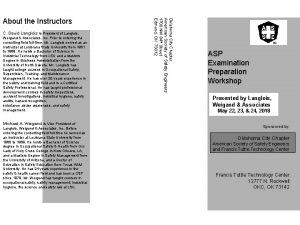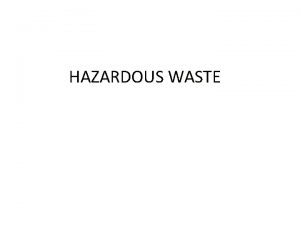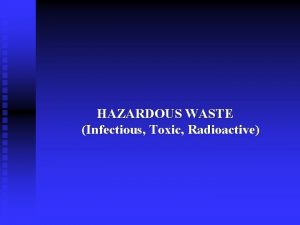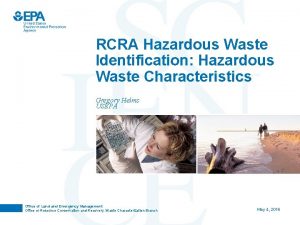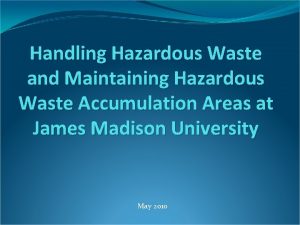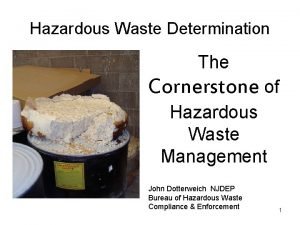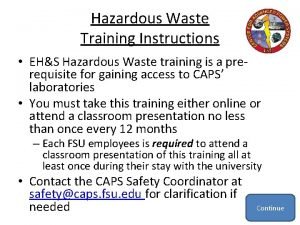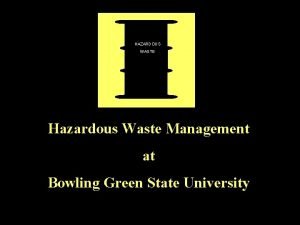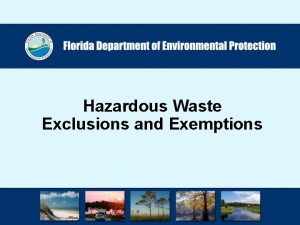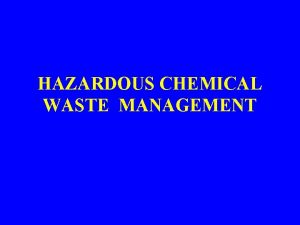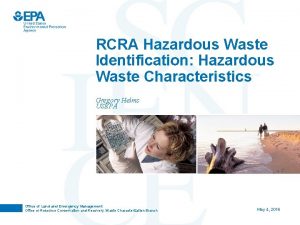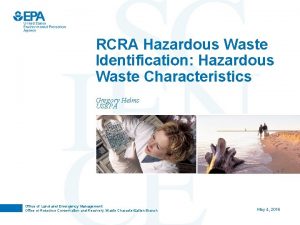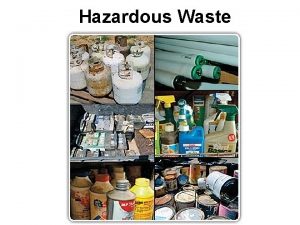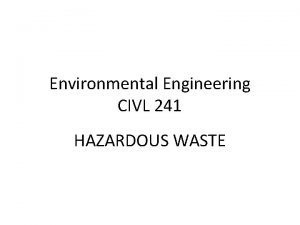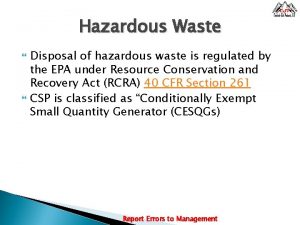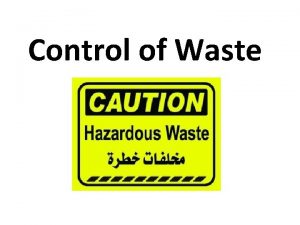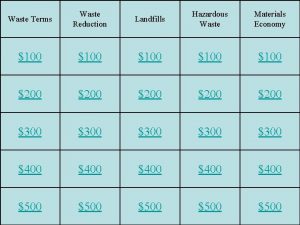Hazardous Waste Copyright J J Keller Associates Inc



















- Slides: 19

Hazardous Waste Copyright J. J. Keller & Associates, Inc. Content may be modified by subscriber per Keller. Online® service Terms of Use.

RCRA Resource Conservation and Recovery Act RCRA encompasses EPA's solid and hazardous waste regulations ► “Cradle to grave”- the moment the waste is created until it is finally disposed of 1 a

RCRA ► Hazardous wastes can be dangerous to human health and the environment ► Know how to safely work with/around the wastes in your workplace and how to handle them safely. 1 b

Identifying Waste ► What is a waste? • • You decide to dispose of it, thus if you are still using a material, or plan to reuse it, it is not considered a waste Regulated by federal or state agencies 2 a

Identifying Waste ► What is a hazardous waste? • A waste with a chemical composition or other properties that make it capable of causing illness, death, or harm to humans and other life forms when mismanaged or released into the environment. 2 b

Identifying Waste ► Steps to determine hazardous waste • Is it a solid waste? Under RCRA, the term "solid waste" means any waste, whether it is a solid, semisolid, or liquid. • Is it specifically excluded from the RCRA regulations? The waste may still be regulated, but under a different program. For example, industrial wastewater will be regulated under the Clean Water Act. • Is it a listed hazardous waste? • Does it exhibit a hazardous characteristics? 2 c

Identifying Waste ► What is a solid waste? discarded material that is: • • Abandoned Recycled Considered inherently wastelike A military ammunition 2 d

Listed and characteristic waste ► Test for hazardous characteristic(s) Use your basic knowledge, the information described in the regulations, and the information on the SDS of the waste to make a waste characteristic determination. ► Generator knowledge Generators can use knowledge of the process used to generate the waste or 'common knowledge' to determine that the waste is a hazardous. For instance, it is common knowledge that gasoline is ignitable. Generators must keep records of all waste determinations, including any test results, waste analyses, or other documentation. 3 b

Listed and characteristic waste ► Ignitability (I): Can create fires under certain conditions. ► Corrosivity (C): Acids or bases capable of corroding metal containers. ► Reactivity (R): Unstable under "normal" conditions. Can cause explosions, toxic fumes, gases, or vapors when heated, compressed, or mixed with water. ► Toxicity (E): Harmful or fatal when ingested or absorbed. When land disposed, contaminated liquid may leach from the waste and pollute ground water. 3 c

Waste Handlers ► Hazardous Waste Generators A facility owner, operator, or person who first c reates a hazardous waste is subject to state or federal regulations. ► Transporters Transportation includes air, rail, highway, or water. Transporters of hazardous wastes are hazmat employees who need or have received proper training. ► Treatment, storage, and disposal facilities (TSDFs) The term TSDF groups treatment, storage, and disposal facilities together, but in reality, there are many other combinations of the three. 4 a

Waste Containers ► Waste in the hazardous waste storage areas must be marked with the date the waste began accumulating (the first drop) and labeled “Hazardous Waste” or must contain the contents of the waste ► Containers must be kept closed and secured except when adding or removing waste

Hazardous Waste Management Central Accumulation Areas ► The main hazardous waste storage area, sometimes called the '90 -day' or '180 -day' area ► Leave enough aisle space between containers to allow firefighters, emergency responders, fire protection equipment, or spill control equipment to move easily between them in an emergency. 6 a

Hazardous Waste Management ► Container management • • • Good condition, no leaks Waste compatibility Keep containers closed! Handle with care Store ignitable or reactive wastes at least 15 meters from property line Inspect containers for leaks once per week 6 c

Hazardous Waste Management If waste is ignitable or reactive: • • • Take special precautions “NO SMOKING” Avoid mixing Appropriate container Avoid heat-producing reactions 6 e

Employee Safety ► Job-specific training Employees must be trained to work safely around and with the waste they may come into contact with on the job. OSHA requires training to be function/job specific. This means employees must know how to protect themselves from the specific wastes at their facility. ► Proper PPE Training includes learning about job specific personal protective equipment (PPE). Consult the SDS on the required protective measures for individual chemicals/wastes. 9 a

Emergency Response Employees must not respond to an emergency unless they are properly trained to do so; you must be trained in emergency procedures. Employees need to know the location and function of any and all emergency equipment they will be expected to use. 11 b

Other Regulated Waste ► Universal waste 40 CFR 273 • • Batteries Lamps (Compact fluorescent light bulbs) Mercury-containing equipment (thermostats, switches) Pesticides (certain recalled or unused) *Contact EH&S for proper disposal 13 a

Other regulated waste ► Universal wastes • • Keep in closed containers Mark the accumulation date Store up to one year Check with your state for other requirements 13 b

Summary ► Hazardous waste training • • Facility/Waste/Job specific Know your role in an emergency 14 a
 Keller hazardous waste disposal
Keller hazardous waste disposal Solid and hazardous waste
Solid and hazardous waste What is toxic waste
What is toxic waste Rcra hazardous waste refresher
Rcra hazardous waste refresher Section 3 hazardous waste answers
Section 3 hazardous waste answers Stanislaus county hazardous materials division
Stanislaus county hazardous materials division Screw feed technology of waste management
Screw feed technology of waste management Segregation of hazardous waste
Segregation of hazardous waste Hazardous waste apes
Hazardous waste apes Courtright & associates inc
Courtright & associates inc Langlois weigand & associates inc
Langlois weigand & associates inc Gl
Gl Copyright 2010 pearson education inc
Copyright 2010 pearson education inc 2017 pearson education inc
2017 pearson education inc 2009 pearson education inc
2009 pearson education inc Copyright pearson education inc
Copyright pearson education inc Copyright 2014 pearson education inc
Copyright 2014 pearson education inc Pearson education inc all rights reserved
Pearson education inc all rights reserved Copyright 2003 pearson education inc
Copyright 2003 pearson education inc 2009 pearson education inc
2009 pearson education inc
